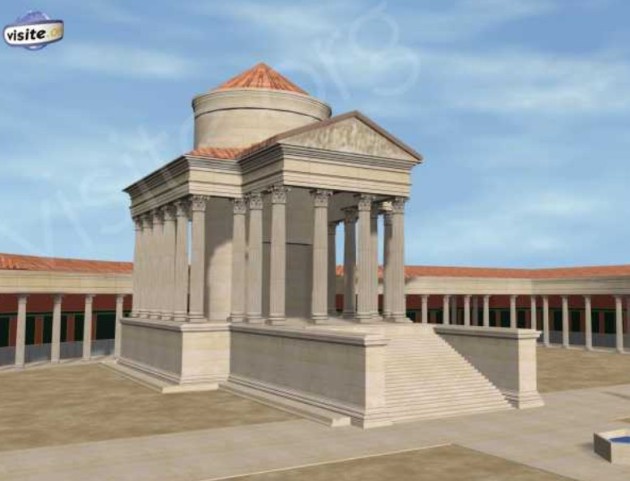Romanisation of the civic pantheon
No matter what their legal status, Gallo-Roman civitates were adopting a pantheon made up with divinities whose functions complemented each other, ensuring the protection of some or all members of the established community. Our knowledge of these divinities is documented in the first place by inscriptions referring to theonyms. It makes it possible to glean the complex modalities linking up pre-Roman to Roman pantheons via interpretatio Romana[1], assimilation, association.
The very first literary witness to interpretatio Romana actually concerns Gaulish gods: in the accounts of his military operation in Gaul between 58 and 52 BC, Julius Caesar introduces the gods honoured by the Gauls (Bello Gallico VI, 17) by giving them the names of the Roman gods whose functions are closest to their own. So what matters to the Romans is less the name of foreign divinities than their sphere of influence, through which they can be “twinned” with a Roman divinity. In a number of cases, the proximity of their function makes it possible for the ruling power to substitute, in an acceptable way, great Roman gods to local divinities. The colony of Narbonne is a case in point, highlighting one of the formulae used in the process. The colony formed after the conquest of Transalpine Gaul in 118 BC was given the name of Narbo Martius, a name that can be found in Cicero[2]'s texts in the middle of the first century BC. The hypothesis according to which the name of the great Roman war god Mars had been given the colony in order to highlight its military function is to be dismissed: the name of the colony, if compared to that of other Roman colonies – Iunonia Carthago, Tarentum Neptunia –, is much more likely to evoke the main pre-Roman divinity honoured on the site of the colony in the making. The place's new occupiers, having imported their lifestyle, their political and religious institutions also chose to impose as their tutelary divinity the Roman god most suitably equivalent to the pre-Roman god.
Here the name of the indigenous divinity has wholly disappeared, but it was not so everywhere: in the Three Gauls, major divinities theonyms are made up with one Gaulish name and a Roman one, displaying another kind of relation between indigenous and Roman pantheons. A range of records help us understand the association and assimilation processes:
The Pillar of the Boatmen, offered by Lutetia's guild of boatmen to Emperor Tiberius is a remarkable example of the association of major indigenous and Roman gods by way of their powers. Gaulish and Roman gods of war, fertility, commerce are represented on a pillar dedicated to the Romans' chief god, Jupiter. This monument attests to the redefining of the religious pantheon that came with the setting up of Roman civic structures.

Trier was the administrative centre for the Treveri's civitas, a Latin colony on the River Moselle in Belgic Gaul. In this administrative centre, founded towards the middle of the first century, several cultural complexes can still be identified. That of the Irminenwingert, situated on the outside of the town, beyond the Moselle includes a temple built before the beginning of the second century later surrounded by a wall that took in two more chapels and was adjoined by a theatre and Roman bath. Inscriptions indicate that several divinities were honoured therein, among whom Lenus Mars. This divinity arises from an association between a major male divinity worshiped by the Treveri and a great Roman god. Some inscriptions found on Treviran territory bear the theonym Lenus alone, which confirms that a pre-Roman divinity had born that name. They also indicate that the cult of a major god fell to a flamen[4] of equestrian rank, that is, according to Roman religious institutions, a priest attached to the cult of a specific god. There are good causes to believe that this great god was Lenus Mars; the Roman's warring god had been adjoined to a Treviran tutelary divinity in the framework of thoroughly Romanized cult and sanctuary.
The god Mars Mullo worshiped in Western Gaul from the mid first century presents a similar case: this divinity was the object of a cult in the great sanctuary of Allonnes (Sarthe, France) at the gates of the capital of the Aulerci Cenomani's civitas, and also at Craon, in modern day Mayenne, in Nantes, among the Namnetes and in Rennes among the Redones. Inscriptions in Rennes show that Mullo was a divinity honoured by one of the territory's pagi[5] in the days of Independent Gaul[6] and that it was chosen to become, joined with the Roman god Mars, the civitas' major divinity. This god had this particularity that he was honoured by several civitates in Western Gaul, which on the basis of current knowledge is a unicum[7]. The god's iconography confirms the changes Roman influence effected in his representation: types of the god Mars varied from a region to another but evince a generalised adoption of the Greco-Roman models as can be seen in what is thought to be a figure of the god found in Allonnes. This head, which comes from a sculpted relief, is of a helmeted divinity given a tragic air by its raised eyes and whose hair curls along its neck. It belongs to the type of a juvenile naked Mars inspired by portraits of Alexander of Macedon[8], well attested in Roman Gaul. The newcomer Mars Mullo was therefore, like other associated gods, an integral component of the new Roman order, which close on two centuries after the conquest, was firmly in place.
 Informations[9]
Informations[9]
 Informations[10]
Informations[10]The redefining of Gallo-Roman cities' pantheon, corollary to the modification of the political structures, took numerous forms according to historical contexts and local situations. Yet everywhere Roman models prevailed, sometimes purely and simply replacing the pre-Roman ones, frequently twinning with a traditional god. The civitates placed themselves under the aegis of plural divinities whose combined powers offered them maximal protection.







